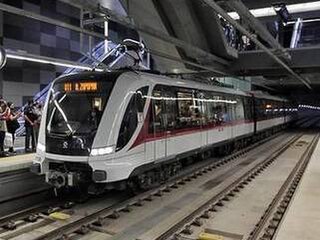
Zona Centro is the historic center of Guadalajara, in the Mexican state of Jalisco.

Zona Centro is the historic center of Guadalajara, in the Mexican state of Jalisco.
The area includes many tourist attractions, [1] including Guadalajara Cathedral, the Rotonda de los Jaliscienses Ilustres, and the surrounding plazas: Plaza de Armas, Plaza de la Liberación, Plaza Guadalajara. Inmolación de Quetzalcóatl is installed in Plaza Tapatía. Parque Morelos, Plaza Fundadores, and the Monumento a la Independencia are in Centro.
Notable buildings include the Palacio de Gobierno de Jalisco, Teatro Degollado, Templo de Nuestra Señora de Aranzazú, Templo de Nuestra Señora del Carmen, Templo de Jesús María, Templo de San Agustín, Templo de Santa María de Gracia, and Templo de Santa Teresa de Jesús.

Guadalajara is a metropolis in western Mexico and the capital of the state of Jalisco. According to the 2020 census, the city has a population of 1,385,629 people, while the Guadalajara metropolitan area has a population of 5,268,642 people, making it the third-largest metropolitan area in the country and the twentieth largest metropolitan area in the Americas Guadalajara has the second-highest population density in Mexico, with over 10,361 people per square kilometer. Within Mexico, Guadalajara is a center of business, arts and culture, technology and tourism; as well as the economic center of the Bajío region. It usually ranks among the 100 most productive and globally competitive cities in the world. It is home to numerous landmarks, including Guadalajara Cathedral, the Teatro Degollado, the Templo Expiatorio, the UNESCO World Heritage site Hospicio Cabañas, and the San Juan de Dios Market—the largest indoor market in Latin America.

San Luis Potosí, commonly called SLP or simply San Luis, is the capital and the most populous city of the Mexican state of San Luis Potosí. It is the municipal seat of the surrounding municipality of San Luis Potosí. The city lies at an elevation of 1,864 metres. It has an estimated population of 824,229 in the city proper and a population of approximately 1,221,526 in its metropolitan area, formed with the neighbour city of Soledad de Graciano Sánchez and other surrounding municipalities, which makes the metropolitan area of Greater San Luis Potosí the eleventh largest in Mexico.

The Sistema de Tren Eléctrico Urbano, is an urban rail transit system serving the Guadalajara metropolitan area, in the municipalities of Guadalajara, Zapopan and Tlaquepaque, in the state of Jalisco, Mexico. It is owned by the state of Jalisco, and is operated by the state authority SITEUR. Opened in 1989, the system consists of three lines: Line 1, running from north to south with 20 stations; Line 2, running from the city center to the east with 10 stations; and Line 3, running from the north-west to south-east with 18 stations. A fourth line is under construction, which will run from the city center to the south of the metropolitan area.

The Camino Real de Tierra Adentro, also known as the Silver Route, was a Spanish 2,560-kilometre-long (1,590 mi) road between Mexico City and San Juan Pueblo, New Mexico, USA, that was used from 1598 to 1882. It was the northernmost of the four major "royal roads" that linked Mexico City to its major tributaries during and after the Spanish colonial era.

Ixtlán del Río is both a municipality and municipal seat in the Mexican state of Nayarit. In 2018 the population of the municipality was 33,289 and the total area was 581.4 km².

The Basilica of Our Lady of Zapopan and the abbey of Our lady of zapopan of Zapopan are a 17th-century Franciscan sanctuary built in downtown Zapopan, in the state of Jalisco, México.

The Guadalajara Cathedral or Cathedral of the Assumption of Our Lady, located in Centro, Guadalajara, Jalisco, is the Roman Catholic cathedral of the Archdiocese of Guadalajara and a minor basilica. It is built in the Spanish Renaissance style, except its neo-Gothic spires.

Jalisco, officially the Free and Sovereign State of Jalisco, is one of the 31 states which, along with Mexico City, comprise the 32 Federal Entities of Mexico. It is located in Western Mexico and is bordered by six states, which are Nayarit, Zacatecas, Aguascalientes, Guanajuato, Michoacán, and Colima. Jalisco is divided into 125 municipalities, and its capital and largest city is Guadalajara.

The Nuestra Señora de Loreto Church in the historic center of Mexico City was the last major church constructed during the colonial period. Constructed between 1806 and 1819, the church tilts significantly to one side due to being constructed of stone of two different weights. Loreto is one of a number of churches in the historic district that the Archdiocese of Mexico says is in imminent danger of being lost due to structural damage from the uneven sinking. In front of the church is a plaza named after the church which used to be the site of Mexico City’s first synagogue.
The following is a timeline of the history of the city of Guadalajara, Mexico.
Fray Nicolás of Jesús María was a religious carmelita born in Seville, Spain, during the last years of the reign of Carlos II (1734-1759). His parents were Francisco Sánchez Risco and María de Merino, whom called him Nicolás Sánchez Risco y Merino.

Templo de Nuestra Señora de Aranzazú is a church in Centro, Guadalajara, in the Mexican state of Jalisco.

Templo de Nuestra Señora del Carmen is a church in Centro, Guadalajara, in the Mexican state of Jalisco. The building, whose construction began in 1690, is considered an example of neoclassical architecture following a 19th-century renovation that resulted from the widening of the avenue on which it's located.

Templo de Santa Teresa de Jesús is a church in Centro, Guadalajara, in the Mexican state of Jalisco.

Templo de Jesús María is a church in Centro, Guadalajara, in the Mexican state of Jalisco.

Templo de Santa María de Gracia is a church in Centro, Guadalajara, in the Mexican state of Jalisco.

Guadalajara Centro railway station is the ninth station of Line 3 of Guadalajara's light rail system from south-east to north-west, and the tenth in the opposite direction; it is also a station with a large influx of passengers because it acts as a transfer station with Plaza Universidad on Line 2 of the system.